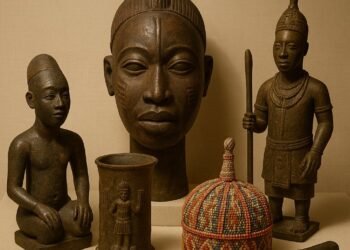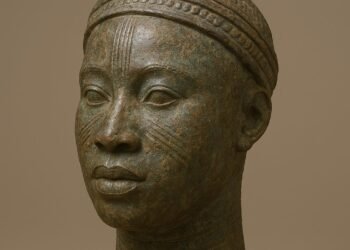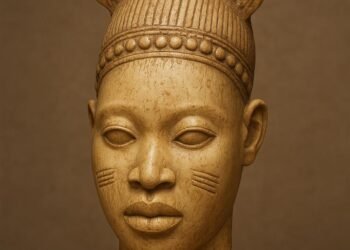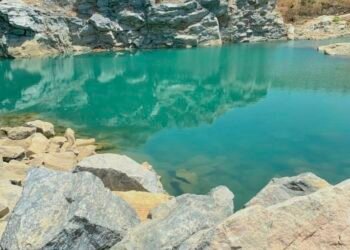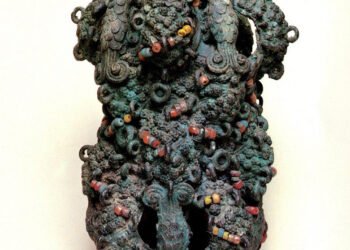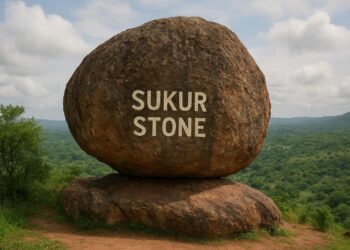The Fascinating Origins of Oron Kingdom
As a historic center of culture and identity, the Oron Kingdom is situated in the heart of Akwa Ibom State, Nigeria, also known as Akpakip Oro. This ancient group of people has survived as a distinct community for millennia, making a rich and established cultural contribution to life and identity in the region. Their subjects have included various forms of artistic expression, acts of courageous leadership, and resilient adaptation.
Greater than a footnote to history, Oron is a living heritage that continues to shape community life and cultural expression today. From its holy Ekpu carvings to the mighty Ekpe society, the kingdom offers a rich story of creativity and continuity, inviting us to explore one of West Africa’s most enduring civilizations.
Table of Contents
The History and Path of the Oron People
The Oron people have a history that dates back to a remote past, as verified by ancient relics and contemporary science. The lovely wooden Ekpu sculptures you may have viewed in museums? They are more than art; they are like a family photograph album, going back as far as 2370 BC. Every character has a story to tell, keeping the record of ancestors long before written words.

Read Also: Discover the Beauty of Bwari Rock in Abuja, Nigeria
However, there’s more to the mystery. Genetically, research indicates that most Oron share a DNA marker known as E1b1a1-M2, which is found in Northeast Africa. It is estimated that their forebears started a gradual but continuous migration as the Sahara dried out some 3500 BCE. They migrated south, most likely in search of farming opportunities and fresh land, ultimately settling in the Cross River area.
By 1200 CE, these civilizations had organized into the more structured and prosperous Oron Kingdom. This was a state, not a tribe or village, and its institutions, values, and sense of self persist to this day.
Societal Structure and Governance
The Oron developed a uniquely egalitarian and effective sociopolitical system. They were organized into nine primary clans known as Afaha, including Afaha Ukwong, Ebughu, and Effiat.
This clan system formed the bedrock of their social organization. At the helm of their governance was a selective monarchy with a rotatory kingship.
The Ahta Oro, the royal stool established in the late 1200s, served as the highest traditional authority. Ahta aya-Arah, the first King, is honored and revered within oral tradition as a kind and generous provider to his people, who brought a new type of sweet yam to his people, and said it was a food from the gods to eliminate hunger.
Read Also: Arochukwu Long Juju Shrine: Unveiling Ancient Traditions
This governance was powerfully upheld by the Ekpe secret society, which was a system of governance that combined legislative, executive, and judicial functions, maintaining peace and justice in the Kingdom.
The Role of Ekpe Society in Oron Society
Have you ever taken the time to ask yourself how a society maintains itself and enforces its values without a professionalized police force and written laws? For the Oron people, the solution was the Ékpè society, a solid and highly esteemed institution that served as the backbone of their society. Think of Ékpè as the government, legal system, and cultural guardian of the community.
It was organized into seven ranks, each with its own responsibilities and level of trust. Rising up, through titles like Nyamkpe, Nkanda, and all the way to Eyamba, was something that required wisdom, devotion, and effort on the part of the people. Over them stood the Offong Ekpie, a king whose decision was final and not to be questioned.
But Ékpè was more than a pecking order. It ensured justice, settled disputes, and made decisions that involved everyone. It was not merely a question of power, but also about ensuring the people remained together, safe, and loyal to their traditions for centuries. Even today, Ékpè’s legacy reminds us of how culture and government can be blended into something very enduring.
Oron Artistic Traditions and Cultural Heritage
The Oron did not only create art; they put their beliefs, identity, and spirit into what they created. At the heart of their culture was a profound spiritual view of the world, centered on Abazi Udung Oyong, the God of the Sky, who guided their perspective on the world.
This deep respect manifested its most beautiful form in the famous Ekpu statues. Far beyond mere wooden images, these statues were revered vessels, believed to hold the soul of the subject they represented. Each detail, each curve and facial expression, was executed with purpose and care to produce some of Africa’s most beautiful sculptures.
But their artistry was more than that. Oron’s dress also spoke. The men wore the flamboyant red Iyara cap, an emblem of dignity, and the women shone in elaborate beadwork, dancing in cane skirts for the Abang dance, an elegant display of womanhood and society. In these representations, the Oron transformed everyday life into timeless art.
Oron Economy and Sea Trade
How did a kingdom last for so many centuries? The Oron people crafted a strong economy that was set within their nature. They occupied the forefronts of the riverine and coastal areas, and as such, they dominated fishing, agriculture, and commerce. Palm oil was a product tapped and freely exchanged, and it was the lifeblood of their economy. Interestingly, the Ekpe society played a pivotal role in managing these resources, integrating economic and social organization.
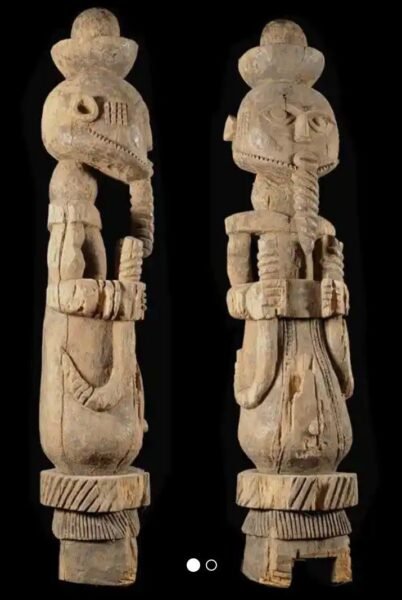
Read Also: Sukur Stone: A Symbol of Ancient Craftmanship
But their true strength lay out at sea. Shipbuilders and sailors extraordinaire, the Oron constructed huge sea-trade routes on the Atlantic seaboard and rivers. That maritime legacy gazes beyond the centuries; it remains relevant today. The crème de la crème Maritime Academy of Nigeria at Oron seeks to uphold that tradition by providing training for tomorrow’s seafarers and shipping professionals. The Oron have always managed to plot a path through economy and water, from ancient trade to modern industry.
Unsolved Mysteries of Oron History
What if I told you that some of Oron’s past remains an intriguing puzzle? The kingdom’s history is filled with fascinating questions that still capture curiosity today. For instance, many have noticed surprising similarities between Oron traditions and those of ancient Egyptian and Hebrew cultures. How did these connections emerge?
One compelling legend recounts the story of Abang, the foundational figure of the Oron people. His story might explain why only two places in the world bear the name Oron: one in Nigeria, and one in Israel.
Then there’s the haunting mystery of the Ekpu statues. These sacred wooden figures, central to Oron’s spiritual life, were lost or looted during the Nigerian Civil War. Their absence remains a deep cultural wound.
And we must not dismiss the painful memories of the war itself, including the bombings in the Urue Oruko market, which have left scars and questions unanswered. But they aren’t just stories. They are unresolved, unfinished memories that have become part of Oron’s identity.
Oron Kingdom in Modern Nigeria
You may be surprised to learn about the significant political transformation of the Oron Nation over time. Once a unified kingdom, modern borders have reshaped its identity. Following British colonialism and subsequent state formation in Nigeria, the Oron today find themselves politically split into two states (Cross River and Akwa Ibom) and five local government areas within Akwa Ibom state (Oron, Okobo, Udung Uko, Mbo, and Urue Ofong Oruko).
To be fair, this has made local governance immensely practicable, but it has also complicated the Oron people’s actual unity. For example, the challenge of asserting a unified collective voice for the Oron people is complicated by the division across various political zones.
What is more difficult, maintaining collective prestige and agency when your people are separated by varying political authorities? Still, despite such complex issues, the Oron people continue to engage politically and maintain their ancient heritage, demonstrating that cultural practices are multi-dimensional and fluid across political divisions.
Oron People Today and Tomorrow
The Oron people are members of present-day Nigeria. The Oron people today have a living population of approximately 1.4 million in Nigeria and Cameroon. The cultural diffusion and impact are largely contingent, among other factors, on how they have responded to intended change over the years. Today, Oron town (in Akwa Ibom State) has become the 3rd largest in the state, a bustling urban area where both tradition and modernity co-exist or intermingle.
The discovery of oil and gas deposits in their area has brought both promise and difficulty. While they offer economic promise, the promise of economic development has also raised fundamental issues about environmental sustainability and the fair distribution of resources.
In the meantime, groups such as the Oron Union are busy preserving their heritage and promoting community interests. Most impressive is how the Oron people manage to maintain their distinct identity and actually shape their destiny—evidence that ancient people can not only exist but flourish in our contemporary world.

